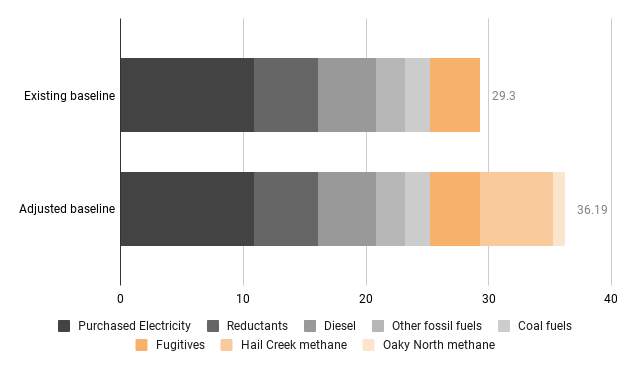Stay Informed
Get email updates about new ACCR research and shareholder advocacy on specific topics of interest to you.
Sign UpThe Australasian Centre for Corporate Responsibility (ACCR) has published new analysis of the impact of underreported methane emissions on Glencore’s operational emissions footprint.
Based on estimates from the SRON Netherlands Institute for Space Research, ACCR conservatively estimates that Glencore has underreported its operational emissions by 11-24% between 2018 and 2021.
Glencore’s 2019 emissions baseline is understated by at least 6.9 million tonnes CO2e or 24%. Glencore’s 2019 emissions are significant, because it is the baseline year for its 2026, 2035 and 2050 emissions reduction targets.
Methane emissions from the Hail Creek coal mine in Queensland were at least 13 times greater than what Glencore disclosed in its 2019 emissions inventory. Methane emissions from the Oaky North coal mine were at least double what was included in its 2019 emissions inventory.
Methane is a critically important greenhouse gas, and far more potent than carbon dioxide in the short term.
Dan Gocher, Director of Climate & Environment at the Australasian Centre for Corporate Responsibility (ACCR) said:
“The satellite data is damning for Glencore, as it has failed to disclose to shareholders the excessive methane emissions from its Bowen Basin coal mining operations.
“The underreporting of methane emissions is a material risk for shareholders, and this analysis is yet another reason to vote against Glencore’s progress on its climate plan at its AGM on 28 April.
“Whether this is a mistake or a blatant misreporting of emissions, the Board needs to be held to account. As such, shareholders should oppose the re-election of Peter Coates given his role as Chair of the Health, Safety, Environment and Communities Committee.
“Of utmost concern are Glencore’s 2019 emissions as that is the baseline year for its 2026, 2035 and 2050 emissions reductions targets.
“Glencore’s entire climate strategy should be called into question.
“Glencore has previously attempted to discredit the peer-reviewed research which identified excessive methane emissions from its Hail Creek and Oaky North coal mines. Given Glencore’s record of disputing climate science, this is hardly surprising.
“It’s possible that the excessive methane emissions from the Hail Creek mine were intentional—the result of a process known as premining degasification, where methane is intentionally vented or flared for safety reasons. If Glencore knowingly excluded the emissions from its disclosures, then it points to a much more critical governance issue within the company.
“Glencore has not disclosed to shareholders how it measures and manages methane emissions from its coal mining operations, nor how it intends to reduce those emissions in order to meet its emission reduction targets.
“Even the International Energy Agency believes that Australia is underreporting fugitive methane emissions in its national inventory.
“In addition to this issue with methane emissions, Glencore’s coal expansion plans are at odds with its commitment to a ‘responsible managed decline’ of its coal portfolio and in clear conflict with its commitment to the Paris Agreement.”
ACCR’s analysis—Glencore’s methane problem—is published here.
ACCR’s analysis of Glencore’s progress against its climate plan is published here.
Glencore’s operational emissions, adjusted for additional methane emissions (MtCO2e)
| 2018 | 2019 | 2020 | 2021* | |||
|---|---|---|---|---|---|---|
| Direct emissions by source (Scope 1) | Fossil fuels | Solid fossil fuels | 1.9 | 2.3 | 1.9 | 1.9 |
| Liquid fossil fuels | 5.7 | 5.3 | 4.3 | 4.3 | ||
| Gaseous fossil fuels | 0.7 | 1.1 | 0.7 | 0.7 | ||
| Reductants | 5.6 | 5.2 | 4.1 | 4.1 | ||
| Emissions from fossil fuel extraction | Underground | 3.0 | 2.2 | 1.7 | 1.7 | |
| Open pit and stockpiling | 1.2 | 1.5 | 1.3 | 1.3 | ||
| Decommissioned mines | 0.3 | 0.4 | 0.6 | 0.6 | ||
| Other direct GHG emissions | 0.4 | 0.4 | 0.4 | 0.4 | ||
| Indirect emissions (Scope 2) | 11.7 | 11.0 | 9.3 | 10.8 | ||
| Total | 30.5 | 29.3 | 24.3 | 25.8 | ||
| Hail Creek additional methane | 2.7 | 6.4 | 5.0 | 5.4 | ||
| less Hail Creek reported emissions | -0.2 | -0.5 | -0.5 | -0.5 | ||
| Oaky North additional methane | 2.1 | 2.1 | NA | NA | ||
| less Oaky North reported emissions | -1.1 | -1.1 | NA | NA | ||
| Total including additional methane | 34.0 | 36.2 | 28.5 | 30.7 | ||
| Percentage increase | 11% | 24% | 18% | 19% |
Source: Glencore plc, Sadavarte et al (2021), Clean Energy Regulator
*2021 ESG Data Book not yet published, so 2020 Scope 1 emissions were used as a proxy.
Glencore’s Scope 1+2 2019 emissions baseline, existing and adjusted (MtCO2e)
